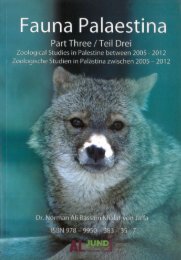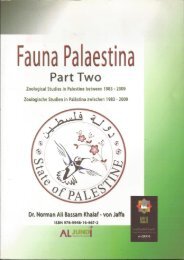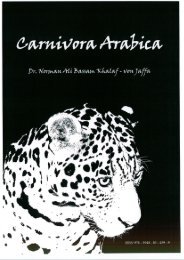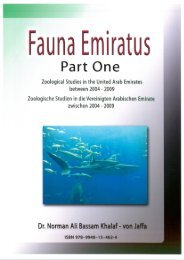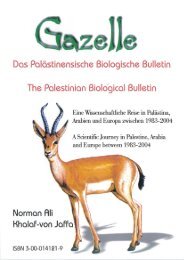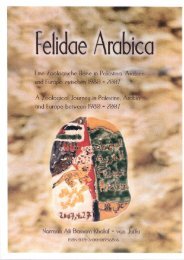- Page 2 and 3:
Fauna Palaestina 1
- Page 4 and 5:
Prof. Dr. Norman Ali Bassam Khalaf-
- Page 6 and 7:
اقْرَأْ بِاسْ م
- Page 8 and 9:
Contents Fauna Palaestina - Part Fo
- Page 10 and 11:
IN THE NAME OF ALLAH, MOST GRACIOUS
- Page 12 and 13:
11
- Page 14 and 15:
worldwide (since 1983); and the aut
- Page 16 and 17:
Checklist of the Family Scarabaeida
- Page 18 and 19:
Photo by Oz Rittner. http://www.nat
- Page 20 and 21:
Tanyproctus (Taniproctocera) crinit
- Page 22 and 23:
Adoretus granulifrons Fairmaire, 18
- Page 24 and 25:
Tribe Pentodontini Photo by Oz Ritt
- Page 26 and 27:
Photo by Oz Rittner. http://www.nat
- Page 28 and 29:
Photo by Oz Rittner. http://www.nat
- Page 30 and 31:
Onitis alexis ssp. septentrionalis
- Page 32 and 33:
Onthophagus (Palaeonthophagus) fiss
- Page 34 and 35:
Scarabaeus (Scarabaeus) pius (Illig
- Page 36 and 37:
Erytus mesopotamicus (Petrovitz, 19
- Page 38 and 39:
Mesontoplatys arabicus (Harold, 187
- Page 40 and 41:
http://www.nature-of-oz.com/Subrinu
- Page 42 and 43:
Rhyssemodes orientalis (Mulsant and
- Page 44 and 45:
ooks.webs.com/ Khalaf-Sakerfalke vo
- Page 46 and 47:
http://www.tandfonline.com/doi/abs/
- Page 48 and 49:
Family Coccinellidae (Ladybird Beet
- Page 50 and 51:
14-Spot Ladybird Beetle (Propylea q
- Page 52 and 53:
name ―Marienkäfer‖ translates
- Page 54 and 55:
much larger scarabaeid grapevine be
- Page 56 and 57:
of them particularly valuable as ag
- Page 58 and 59:
from making a meal of them. This ph
- Page 60 and 61:
7-Spot Ladybird (Coccinella septemp
- Page 62 and 63:
In both Hebrew and Yiddish, it is c
- Page 64 and 65:
coronaria). A Quarterly Magazine Is
- Page 66 and 67:
Khalaf-von Jaffa, Dr. Norman Ali Ba
- Page 68 and 69:
to Florida. Entomology Circular Num
- Page 70 and 71:
Freshwater Fishes in Palestine أس
- Page 72 and 73:
In addition there are a number of f
- Page 74 and 75:
Status of the class species in Pale
- Page 76 and 77:
Perciformes Cichlidae Oreochromis m
- Page 78 and 79:
Galil, B., M. Goren, R. Ortal (2001
- Page 80 and 81:
dispar and Aphanius mento (Cyprinod
- Page 82 and 83:
Mathaf Al-‗Ilmi Bi-Dawlat Al-Kuwa
- Page 84 and 85:
(seit Juni 2001). Yahoo! Deutschlan
- Page 86 and 87:
Dissertation in Ecology, Department
- Page 88 and 89:
South Palestine: First Records from
- Page 90 and 91:
Khalaf-von Jaffa, Dr. Sc. Norman Al
- Page 92 and 93:
91
- Page 94 and 95:
Abstract: A new subspecies of Docto
- Page 96 and 97:
water currents. Teeth are hooked at
- Page 98 and 99:
in breeding males and the caudal fi
- Page 100 and 101:
to 18.5 cm total length are known f
- Page 102 and 103:
The Palestine Doctor Fish Discovery
- Page 104 and 105:
Lebanon, Palestine, Israel, Saudi A
- Page 106 and 107:
Etymology / Derivation of the Scien
- Page 108 and 109:
Subordinated taxa Number of records
- Page 110 and 111:
Feulner, G.R. (1998). Wadi Fish of
- Page 112 and 113:
Khalaf, Norman (Translator) (1982).
- Page 114 and 115:
pp. 1-7. Khalaf, Norman Ali Bassam
- Page 116 and 117:
The Habitat of the Palestine Doctor
- Page 118 and 119:
Wissenschaftliche Reise in Palästi
- Page 120 and 121:
(2007). Rhiniodon typus Smith, 1828
- Page 122 and 123:
(2009). Bowmouth Guitarfish (Rhina
- Page 124 and 125:
Khalaf-von Jaffa, Prof. Dr. Sc. Nor
- Page 126 and 127:
125
- Page 128 and 129:
Family Latimeriidae) was found at t
- Page 130 and 131:
many fine striations. Those scales
- Page 132 and 133:
Taxon profile > Taxon Profile: spec
- Page 134 and 135:
http://www.organismnames.com/namede
- Page 136 and 137:
A note on the Coelacanth of Kuwait.
- Page 138 and 139:
the Western Central Atlantic. Vol.
- Page 140 and 141:
139
- Page 142 and 143:
not so well known. Thanks to Prof.
- Page 144 and 145:
A small Dinosaur inside an egg at B
- Page 146 and 147:
One of the Beit Zeit Dinosaur Footp
- Page 148 and 149:
species. The most frequent type is
- Page 150 and 151:
Beit Zeit Dinosaur Tracks from Beit
- Page 152 and 153:
included Saurornitholestes, Dromaeo
- Page 154 and 155:
What is known about Elaphrosaurs co
- Page 156 and 157:
Beit Zeit Dinosaur Footprints from
- Page 158 and 159:
(2008) and Carrano et al. (2012) as
- Page 160 and 161:
Beit Zeit Dinosaur Tracks from Beit
- Page 162 and 163:
Prof. Dr. Norman Ali Bassam Khalaf-
- Page 164 and 165:
stratigraphic zones 2-4 of the Morr
- Page 166 and 167:
Prof. Dr. Norman Ali Bassam Khalaf-
- Page 168 and 169:
Avnimelech, Nirit and Bervoets, Fre
- Page 170 and 171:
Sitzungsberichte der Gessellschaft
- Page 172 and 173:
coronaria). A Quarterly Magazine Is
- Page 174 and 175:
Palestinian Biological Bulletin. Nu
- Page 176 and 177:
Jundi Publishing House, Jerusalem,
- Page 178 and 179:
A large Dinosaur Footprint at Dubai
- Page 180 and 181:
Beit Zeit Dinosaur Footprint. http:
- Page 182 and 183:
181
- Page 184 and 185:
17-33 years and has a lifespan of 4
- Page 186 and 187:
the nests were located
- Page 188 and 189:
Khalaf, N.A.B. (1986). The Schoolin
- Page 190 and 191:
Khalaf-Sakerfalke von Jaffa, Norman
- Page 192 and 193:
- Part Three. Zoological Studies in
- Page 194 and 195:
Prof. Dr. Sc. Norman Ali Bassam Kha
- Page 196 and 197:
195
- Page 198 and 199:
The fishermen decided to give the s
- Page 200 and 201:
egg clutches and then become quiesc
- Page 202 and 203:
wider heads than females. The sex o
- Page 204 and 205:
Ocean nesting site is Oman, on the
- Page 206 and 207:
Atlantic Ocean, age plays a factor
- Page 208 and 209:
method. They depend entirely on thi
- Page 210 and 211:
loggerheads eat jellyfish, floating
- Page 212 and 213:
Predators Loggerheads have numerous
- Page 214 and 215:
Bald Head Island in North Carolina,
- Page 216 and 217:
After incubating for around 80 days
- Page 218 and 219:
conjunction; if one aid is not avai
- Page 220 and 221:
following two centuries, with the c
- Page 222 and 223:
foraging habitats for juveniles in
- Page 224 and 225:
Conservation Efforts Since the logg
- Page 226 and 227:
the Animal Life in Palestine. Gazel
- Page 228 and 229:
near the Tantura Beach, Carmel Coas
- Page 230 and 231:
State of Palestine. Gazelle: The Pa
- Page 232 and 233:
Records of Dead Loggerhead Sea Turt
- Page 234 and 235:
A Loggerhead Sea Turtle (Caretta ca
- Page 236 and 237:
A Loggerhead Sea Turtle (Caretta ca
- Page 238 and 239:
A Loggerhead Sea Turtle (Caretta ca
- Page 240 and 241:
Khalaf-von Jaffa, Norman Ali Bassam
- Page 242 and 243:
September 2007 CE, Sha‘ban 1428 A
- Page 244 and 245:
350 Pages and the Arabic Part 14 Pa
- Page 246 and 247:
245
- Page 248 and 249:
Human activity has the greatest imp
- Page 250 and 251:
Men from the Palestinian Village of
- Page 252 and 253:
the Indian Subcontinent. Today the
- Page 254 and 255:
wolves in packs can displace single
- Page 256 and 257:
Two road-killed Persian Common Badg
- Page 258 and 259:
A killed Diademed Sand Snake or Awl
- Page 260 and 261:
Don’t Kill Our Wild Life. http://
- Page 262 and 263:
Armed man kills two Palestinian ani
- Page 264 and 265:
Khalaf, Norman (1983). Haywan Al-Gh
- Page 266 and 267:
1426. pp. 1-11. Sharjah, United Ara
- Page 268 and 269:
https://de.groups.yahoo.com/neo/gro
- Page 270 and 271:
Academic Press, London . Mendelssoh
- Page 272 and 273:
271
- Page 274 and 275:
The most distinctive feature of thi
- Page 276 and 277:
Acknowledgments: Special thanks are
- Page 278 and 279:
Amr, Zuhair S. & Disi, A.M. (1988).
- Page 280 and 281:
AUFFRAY, J.-C.; TCHERNOV, E. and NE
- Page 282 and 283:
Clarke, J. E. (1977). A Preliminary
- Page 284 and 285:
Flower, S.S. (1932). Notes on the R
- Page 286 and 287:
Gazelle: The Palestinian Biological
- Page 288 and 289:
Kingdon, J. (1990). Arabian mammals
- Page 290 and 291:
Shargal, E.; Kronfeld-Schor, N. and
- Page 292 and 293:
291
- Page 294 and 295:
References and Internet Websites: K
- Page 296 and 297:
295
- Page 298 and 299: Jackal (Canis aureus lupaster Hempr
- Page 300 and 301: Canis aureus palaestina, new subspe
- Page 302 and 303: Aharoni, Israel (1930). Die Säuget
- Page 304 and 305: Terrestrial Mammals of Palestine. B
- Page 306 and 307: Ellerman, J.R. and T.C.S. Morrison-
- Page 308 and 309: Harrison, David L. (1968). The Mamm
- Page 310 and 311: Education / Children for Nature Pro
- Page 312 and 313: Europe between 1980-2007 / Felidae
- Page 314 and 315: Malcolm, J. R. (1988). A re-census
- Page 316 and 317: acked jackals in an African montane
- Page 318 and 319: 3&_user=10&_rdoc=1&_fmt=&_orig=sear
- Page 320 and 321: The Wolf (Canis lupus) in Palestine
- Page 322 and 323: so far supposed to be the largest w
- Page 324 and 325: about to be exterminated or have al
- Page 326 and 327: of three Canis lupus pallipes were
- Page 328 and 329: Weights of Mediterranean pallipes w
- Page 330 and 331: Araba (Arava), three wolves were se
- Page 332 and 333: wolves and jackals have not been ob
- Page 334 and 335: elation to such mortality factors a
- Page 336 and 337: Publishing House, Jerusalem, State
- Page 338 and 339: The Two Wolf Subspecies (Canis lupu
- Page 340 and 341: The human population of Occupied Pa
- Page 342 and 343: The Arabian Wolf (Canis lupus arabs
- Page 344 and 345: Jaffa, 1990). Scavenging on garbage
- Page 346 and 347: The desert wolves of Arabia usually
- Page 350 and 351: A similar case is occurring with tw
- Page 352 and 353: populations of such wide-ranging an
- Page 354 and 355: scavenging on livestock carcasses a
- Page 356 and 357: Wolf predation on livestock occurs
- Page 358 and 359: A Desert Wolf at Beer Al Sabea (Bee
- Page 360 and 361: and whelped between the end of Marc
- Page 362 and 363: References and Internet Websites: A
- Page 364 and 365: latrans). In The wild canids: their
- Page 366 and 367: 1766) in the Department of Zoology,
- Page 368 and 369: Germany. Number 30, Tenth Year, Oct
- Page 370 and 371: Khalaf-von Jaffa, Norman Ali Bassam
- Page 372 and 373: Mus musculus gazaensis Khalaf, 2007
- Page 374 and 375: etween 1983 - 2006 / Fauna Palaesti
- Page 376 and 377: Die Säugetiere (Mammalia) Syriens
- Page 378 and 379: primates. Molecular & Biological Ev
- Page 380 and 381: 1 حيوانات فلسطين
- Page 382 and 383: حيوانات فلسطين الج
- Page 384 and 385: إهداء خاص إلى قائد
- Page 386 and 387: - إهداء - أٛل١ ً
- Page 388 and 389: ) مُحتويات الكتاب (
- Page 390 and 391: المُقدمة بسم الله ا
- Page 392 and 393: ٤ٍلٗب ُٓؾٔل ٠ِ
- Page 394 and 395: 15
- Page 396 and 397: صفبد جُػ انغُطَط )
- Page 398 and 399:
٢ٛٝ روغ ث٤ٖ
- Page 400 and 401:
انغُطَط )انغُطَطٌ
- Page 402 and 403:
ٝرُٞٙؼ فبهٛخ اإلٗ
- Page 404 and 405:
حُىاٌ انغُطَط انص
- Page 406 and 407:
Bodenheimer, F. S. (1960). Animal a
- Page 408 and 409:
6.11.1982. Biological Society, Kuwa
- Page 410 and 411:
Cooperation with Dept. of General a
- Page 412 and 413:
Common Weasel (Mustela nivalis, Lin
- Page 414 and 415:
1983 - 2014 / Fauna Palaestina - Te
- Page 416 and 417:
37
- Page 418 and 419:
1000 500 عٌ٘ ٝ ٛبئلخ
- Page 420 and 421:
ٝرلٍ ٛجؼبد األ
- Page 422 and 423:
أٓب ثبَُ٘جخ ُٔ٘طو
- Page 424 and 425:
Khalaf, Norman Ali Bassam (1987). O
- Page 426 and 427:
etween 1983 - 2006 / Fauna Palaesti
- Page 428 and 429:
350 Pages and the Arabic Part 14 Pa
- Page 430 and 431:
انًؤنف أيبو انهُكم
- Page 432 and 433:
جبئعح ز. َىضيبٌ
- Page 434 and 435:
إٕ ػٖلٞه أٌُْ ا
- Page 436 and 437:
ػصفىض انشًػ انفهؽط
- Page 438 and 439:
- ُول رٌلَ هللا ث
- Page 440 and 441:
ٍج٤َ أُضب
- Page 442 and 443:
ػصفىض انشًػ انفهؽط
- Page 444 and 445:
ػصفىض انشًػ انفهؽط
- Page 446 and 447:
ًَ ًبئٖ ٓٞعٞك
- Page 448 and 449:
69
- Page 450 and 451:
انجبنؽىٌ : انؽُسح
- Page 452 and 453:
Ramadan 1407 AH, April 1987 AD. pp.
- Page 454 and 455:
Biological Bulletin. ISSN 0178 - 62
- Page 456 and 457:
1856). Gazelle: The Palestinian Bio




